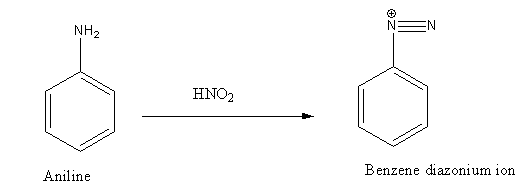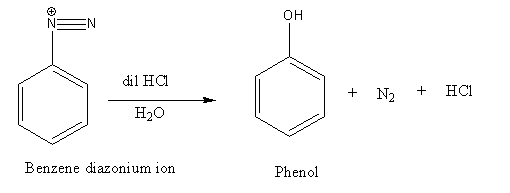Question
Question: Reaction of aniline with \[{\text{HN}}{{\text{O}}_{\text{2}}}\] followed by treatment of dilute acid...
Reaction of aniline with HNO2 followed by treatment of dilute acid gives:
A) C6H5NHOH
B) C6H5OH
C) C6H5NHNH2
D) C6H6
Solution
Aniline reacts similarly to primary aliphatic amines. Aniline gives diazonium ion after treatment with nitrous acid. On further treatment with dilute acid undergo hydrolysis reaction.
Complete solution:
In this reaction, aniline is the reactant and reagent given to us is nitrous acid, HNO2 and dilute acid.
Aniline is the simplest aromatic amine that behaves similarly to primary aliphatic amines. It consists of an amino group bonded to a phenyl group.
Reagent nitrous acid is prepared by reaction of sodium nitrite with hydrochloric acid. It is a weak acid
NaNO2 + HCl→ NaCl + HNO2
Now, we will see the reaction mechanism when of aniline reacts with HNO2 followed by treatment with dilute acid.
Step 1: Conversion of aniline to diazonium ion using nitrous acid, HNO2reagent.

Step 2: Diazonium ion on further treatment with dilute acid undergoes hydrolysis reaction and gives phenol as the product.

Thus, the correct options are (B).
Note: Aromatic diazonium ion is a very important intermediate to produce substituted benzene. The final product depends on reagent use. Here the reagent used is dilute acid so the diazonium ion undergoes a hydrolysis reaction. The addition of water molecules is known as the hydrolysis reaction. Amines on hydrolysis give alcohol as the product while aniline gives phenol as the product.
